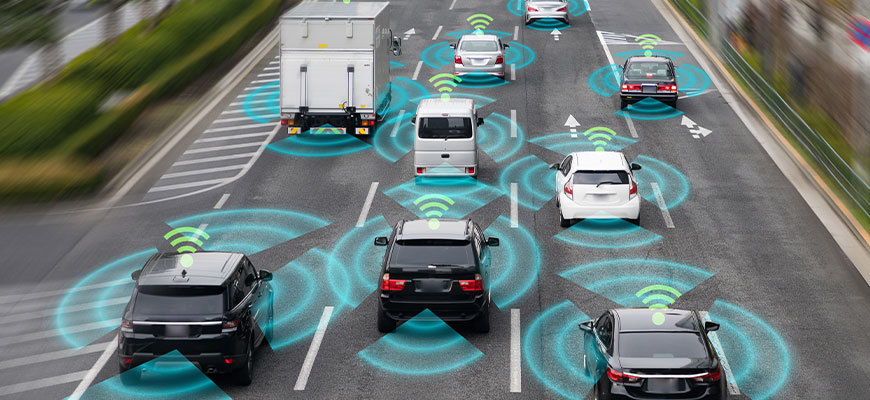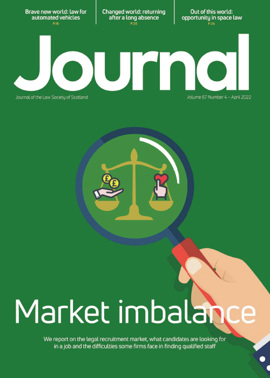Rules of the driverless road

In 2018, the Scottish Law Commission and Law Commission of England & Wales set out to recommend new laws which would prepare Great Britain’s roads for the safe and effective use of automated vehicles (“AVs”). On 26 January of this year, the Commissions published a joint report. The Commissions’ recommendations are made in anticipation of technological developments, and primarily aim for safety, inclusivity and progress. A clear legislative framework could assist the UK to be at the forefront of the AV industry.
The Law Commissions carried out extensive consultation, in the shape of three consultation papers. Given that the recommendations would cover new technologies, the papers sought views on many areas that required consideration – such as coming up with a safety standard for AVs, or dealing with the extensive liability of a “driver” in road traffic legislation.
Building on the responses of many consultees from a variety of sectors, the Commissions put together recommendations for regulating the authorisation and use of AVs in Scotland, England and Wales.
“Self-driving” and safety
Definition of “self-driving”
The Commissions have found that a clear line differentiating “self-driving” and “driver support” features is crucial to ensure safe use of AVs. A clear definition is required so that drivers do not mistakenly rely on driver support features (e.g. cruise control), thinking that the vehicle can drive itself, and cause accidents.
Accordingly, the recommendation is that a vehicle should only be recognised as self-driving for legal purposes if it has been authorised by a regulator to operate in a mode where the user (whether inside or outside the vehicle) is not required to monitor the environment, the vehicle, or the way it drives.
Safety standard
Consultees agreed that AVs should be at the very least safer than a human driver. However, an appropriate safety standard is difficult to evaluate – AVs could avoid the types of accident that are caused by human error, but they might cause accidents that a driver would not.
The need to strike a balance between risks acceptable to the public, and innovation, means that the decision regarding AVs’ safety should be a political one for elected representatives. Accordingly, the Law Commissions recommend that the UK Secretary of State for Transport be the one to decide on the safety standard.
The standard should then be applied by a regulator, who will decide whether an AV is safe enough to be authorised to drive itself on public roads. The standard will also be used post-deployment, to monitor in-use safety.
Misleading marketing
Closely tied to the importance of a safety standard and a clear definition of self-driving is the prevention of misleading marketing that falsely advertises a vehicle as self-driving. There is a risk that vehicles with driver support features are advertised as self-driving, leading drivers to believe that they do not need to pay attention to the vehicle’s behaviour or control it when in fact they do. The Commissions recommend the creation of new offences to prevent such behaviour.
Legal actors
User-in-charge
Many road traffic offences centre around the “driver” and the way the vehicle is being driven, so leaving a vehicle without a driver has the potential to alter liability. Under the recommendations, while the vehicle is driving itself the person in the driving seat would no longer be a driver. Instead they would be a “user-in-charge”.
Users-in-charge would have immunity from driving offences relating to the car’s speed and steering, as that would be under the control of the automated driving system (“ADS”). However, the user-in-charge could still be liable for offences not arising directly from the driving task, such as failing to ensure that children wear seatbelts or that a load is safely secured.
Users-in-charge would also have the responsibility to take over driving when the ADS requires them to do so. This could happen through a “transition demand” issued by the vehicle when it senses that it is in an environment where it can no longer drive itself safely. Accordingly, users-in-charge must be fit and qualified to drive, and would face prosecution for using the vehicle under the influence.
No-user-in-charge
Some authorised AVs will be able to drive themselves in certain environments without a user-in-charge. Valet parking, taxi, private hire or bus services are examples. The operation of these no-user-in-charge (“NUIC”) vehicles would be overseen in a remote centre by a licensed operator. NUIC operators, similarly to the user-in-charge, would not need to monitor the environment but would simply need to respond to alerts where the vehicle encountered problems it could not deal with.
Responding to alerts is safety-critical, so the Law Commissions recommend that NUIC operators should have systems in place to ensure that their personnel can respond effectively. Ways to achieve this may vary, but would include, for example, appropriate cybersecurity, efficient training, and regular staff breaks.
ASDE
Under the recommendations, AVs would go through an approval and authorisation process to ensure that they can safely drive themselves, and if so to determine whether they require a user-in-charge. The process involves an application by an authorised self-driving entity (“ASDE”) to the regulator for authorisation. The ASDE might be a vehicle manufacturer or software developer. If an authorised AV were to drive itself in a manner that would be criminal for a human driver, regulatory sanctions could be imposed on the ASDE in place of the usual criminal prosecution of the driver.
Liability
Criminal or regulatory?
Removing the driver and placing the responsibility for vehicles’ behaviour on the ASDE means that criminal sanctions such as those that apply to drivers would no longer be effective under the Commissions’ recommendations. It would be inappropriate to prosecute the user-in-charge when they are not controlling the vehicle. Further, simply substituting the criminal liability of a driver with that of the ASDE could stifle innovation. Penalties that are too harsh could encourage cover-up. Thus, the Commissions’ view is that the best way to ensure compliance is to promote a no-blame culture that learns from mistakes, and to impose regulatory rather than criminal sanctions. The ASDE or NUIC operator should have a duty of candour, and should face regulatory sanctions for misrepresentation or failure to disclose safety-critical information to the regulator.
The Commissions also found that there should be an individual personally responsible to ensure safety of the vehicle and a transparent culture within the firm. Accordingly they recommend that ASDEs and NUIC operators be required to nominate a responsible person to face criminal liability for misrepresentation or failure to disclose safety-relevant information to the regulator.
In-use safety
The Law Commissions also recommend that after deployment, an AV should be monitored by an in-use regulator. The in-use regulator would ensure that the AV’s behaviour is measured against the safety standard, investigate road traffic infractions, and ensure that users are given relevant information about AVs. The regulator could force the ASDE to take remedial action if a vehicle proves unsafe.
Civil liability
The Automated and Electric Vehicles Act 2018 already regulates civil liability for accidents caused by an authorised (listed) vehicle when self-driving. Under the 2018 Act, the insurer must pay compensation for injury or external damage caused by an AV driving itself, and the keeper of an authorised AV must carry insurance containing this obligation. The insurer is exempt from liability where the vehicle was negligently made to drive itself by the user when it was not safe to do so. Once the insurer has settled the claim with the injured party, or has been sued by them, it may claim from any other party liable for the accident. In disputes involving AVs, data collected by the vehicle will be crucial. Investigators will need to know where and when the accident happened in order to determine whether the self-driving features were turned on, and who (or in the case of an ADS, what) was responsible for the accident. Accordingly, ASDEs should be obliged to retain data for a period of 39 months – the three year civil claims limitation period and an additional three months to allow for the evidence to be gathered.
Interim passenger permit
Most passenger services legislation expressly refers to a “driver”. In order to allow for AVs’ development in provision of public transport, taxi, or hire car services, the Law Commissions recommend an interim passenger permit that would allow trials of AV passenger services. The permit will include requirements for services to be accessible, especially to older and disabled people.
Potential
The joint report has been laid before the UK Parliament and the Scottish Parliament. The UK Government and – in relation to devolved areas such as passenger services regulation – the Scottish Government will now have to decide whether to accept the recommendations and bring them into effect.
The Commissions’ recommendations have the potential to enable the introduction of vehicles which can drive themselves safely. Governed by the right legal framework, AVs could improve the safety of Scottish roads, reduce congestion, increase accessibility and revolutionise passenger services.
Perspectives
Features
Briefings
- Criminal court: Thom bar still applies
- Licensing: tighter rules for the pet trade
- Insolvency: Transition from the COVID measures
- Tax: What did the Spring Statement bring?
- Immigration: Providing a home for Ukrainians
- Scottish Solicitors' Discipline Tribunal
- Property: RCI – what does it involve?
- In-house: Looking for a star







